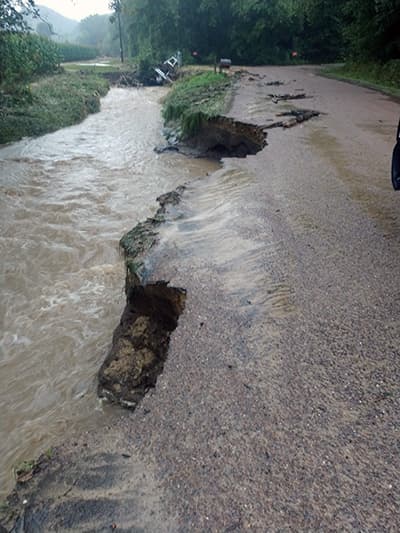Tim Hundt is the district representative for Congressman Ron Kind.
I come at this from a number of perspectives. I grew up here on a 160-acre, 40-cow traditional dairy farm at the top of the Coon Creek Watershed. I grew up with farming practices that started in the ’30s — terracing, contour strips, rotational cropping — all those practices developed in the ’30s that helped save the watershed and eventually saved the whole country by turning around the dust bowl. I didn’t realize how important they were until we experienced the first round of flooding.

Between 2007-2018, about every two years, there was a flood of various degrees. In 2018 the flood was a record-breaker. That was the point when people looked back over the past decade and said “What’s going on? They are telling us we are having 500- and 100-year floods every few years. How can that be?”
It was like a slow-motion catastrophe that is under the radar. You see a hurricane or a wildfire somewhere else in the country, it gets a lot of attention. When you have communities along a river that get wiped out every two years, people think it’s a tragedy but it doesn’t get the attention because it’s happening over this long period of time.
I attended a few flood information meetings that opened my eyes. The more I talked to people I realized they are in a no-win situation. They are in a position where they can’t leave and they can’t stay. You can fix the house but what are you going to do when the house floods again in two years?
In 2019 in Ontario, 19 of their 23 businesses were either severely or completely wiped out. That’s three-quarters of your business community. They didn’t have a gas station for a year. Because of that, there was no place to get groceries. People are wondering how these communities going to be able to survive.
The community of Coon Valley just announced the reopening of their ball field again. That’s about the third or fourth or fifth time. The last time, they barely got it back together and it flooded again. A ball field being ruined doesn’t sound like a big impact from outside the community, but they are really the center of activity in the summertime, especially for youth programs. In Coon Valley they’ve had major league baseball players, like Scott Service, a former professional baseball pitcher who played for several Major League Baseball teams. It’s a huge part of the identity for the region.
For the communities that are living here there’s a sense of holding your breath right now. The dams that were damaged in 2018 are still not repaired. With the dams out people along the Kickapoo and Coon Creek, you get a hard rain now and people get in their cars and drive to high ground. They are nervous and scared for good reason. While solutions are being worked on, they are not as fast as people would like them to be.
Communities are tired. How many times can we do this? We are at that point. We are seeing hope and resilience but people are also waiting to see real change and real help. They want to be less susceptible when the next event happens. Hugh Hammond Bennett helped turn around the dust bowl. After 2018 I really started to see a real parallel here with his work.
We have a real ecological disaster here. Farmers are having a harder time making a living, just like in the ’30s. We need the political willpower to make a change in land use practices. We took the first step forward progressing agriculturally in the ’30s. Now we need to take the next step here 70 years later. We need landscape practices to slow the severe events along with infrastructure to handle the severe events when they get out of control.
The views and opinions expressed in this interview are those of the authors and do not represent official policy or position of the University of Wisconsin-Madison or the Wisconsin Initiative on Climate Change Impacts.
Background
Tim Hundt is a longtime resident and former journalist in Vernon County. From his position as the district representative for Ron Kind’s office in La Crosse, he has been a leader in post-flood resilience planning in the Driftless area.